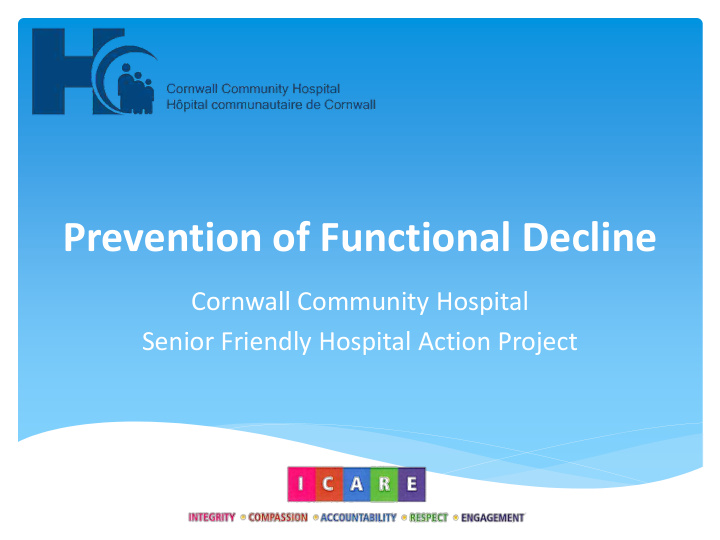



Prevention of Functional Decline Cornwall Community Hospital Senior Friendly Hospital Action Project
Where is Cornwall, Ontario? The City of Cornwall is a small urban centre located in Eastern Ontario. Population: 46,000. The surrounding rural area of Stormont, Dundas and Glengarry covers a geographical area of 3,200 square kilometers and has a population of 111,000.
Cornwall Community Hospital Cornwall Community Hospital • ED Vists/Year: 59,000 (yr15/16) • 137 funded beds Medicine Program • 64 funded beds • 114% overcapacity • 28 ALC patients
The Medicine Program at a glance… • 73% of admitted pts > 65 yrs. • 27% of admitted pts. < 65 yrs. • Top 3 CMGs • Falls rate has include chronic improved; conditions. • Collaboration • Readmission with SFH Team rates for COPD 16%
Functional Decline What is Functional Decline? Functional Decline is … A NEW loss of independence in mobility and performing activi ties of daily living (ADLs) such as dressing, toileting, and bathing. (RGP, 2014)
What causes Functional Decline? • The medical illness causing hospitalization can cause a decline in functional status. • However, up to 50% of older adults experience functional decline during hospitalization that is RELATED TO hospital factors. (RGP, 2014 Updated May 2016)
What is the occurrence of Functional Decline? Who is at Risk? • >73% at CCH (Medicine Program) • Increased Age • Cognitive impairment • Preadmission mobility issues • Pre-existing difficulties with ADLs • Delirium • Depression • Prolonged Hospital stay
Senior Friendly Hospital Action Project (Jan. 2106 – Jan. 1017) Problem Statement • The functional status of admitted patients is not formally assessed. Decline in mobility is a leading complication of hospitalized older patients that can result in an increased risk of adverse events such as falls and incidence of delirium which may prolong length of stay. Our Indicators • Outcome: % of admitted over the age of 65yrs. with LOS>48hrs with no functional decline as assessed by the Barthel Index. • Process: % of admitted patients over the age of 65 with LOS>48hrs who were assessed within 48 hours of admission and discharge using the Barthel Index*.
Implementation: Phased Approach Phase 1 (Jan. 2016-Dec. 2016) Phase 2 (Feb. 2017-Dec. 2017) 1. Staff education and 1. Patient and staff education: awareness: • Strength and balance • Consequences of training immobility • Sit to Stand • Barthel tool (manual and 2. Up for Meals Program electronic) 2. Roll out of the Barthel Tool
December 2015 – October 2017 SFH Cohort 2 Project Initiation Phase 2 SFH Cohort Completion Phase 1 EHR Implementation (Cerner) SFH Cohort 2 Project Initiation
December 2015 – October 2017
Challenges we experienced… Organizational Priorities • Major EHR implementation project – December 2016 Vacation/Time Commitments • Sometimes difficult to meet with Team Roll-Out & Dissemination • Focus on Medicine Department • Education to all clinical areas, but not fully adopted Sustainability
Next Steps…2018 • Continued focus on data collection – working with the electronic health record and building accessible reports • Roll out to other clinical units • Collaboration with Falls Committee - 2 priority projects: Strength and Balance training (Sit to Stand) Up for Meals • Continued use of MOVEON principles • Education: Manager training Nursing Orientation Departmental
Recommend
More recommend